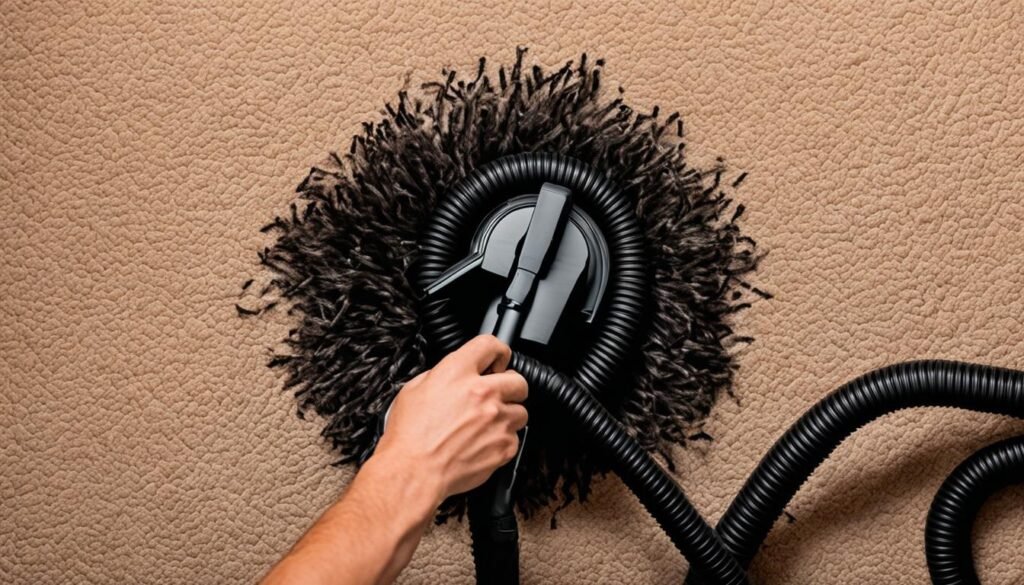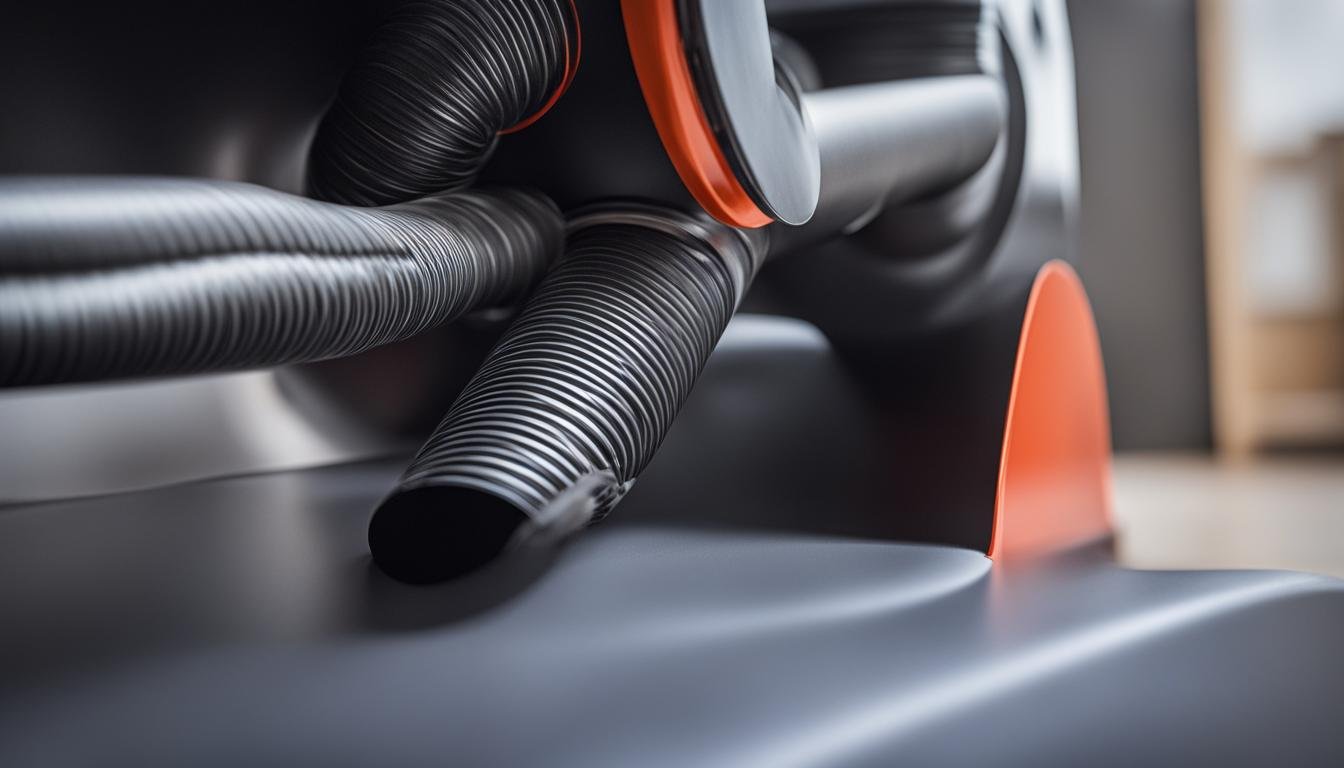Greetings! In this article, I will provide you with valuable information on how to open a vacuum cleaner pipe and clear clogs. Dealing with a clogged vacuum cleaner can be frustrating, but with the right techniques, you can restore its suction power and keep your home clean and dust-free. Let’s dive in!
When it comes to opening a vacuum cleaner pipe, there are a few tried and tested methods you can employ. Begin by following the manufacturer’s instructions to safely detach the hose from your vacuum. Once the hose is disconnected, you can use a broomstick or mop handle to push any large clogs out of the hose. This simple yet effective method can help dislodge stubborn debris and restore your vacuum’s performance.
If you encounter a particularly stubborn clog, there are a couple of hacks you can try. First, you can mix baking soda and vinegar or powdered laundry detergent with hot water and pour it into the hose. This combination helps break up the buildup and facilitates easier removal of the clog. Another method involves rinsing the hose with warm water while manually manipulating the clogged area to dislodge the obstruction. Remember to exercise caution and avoid using excessive force that could damage the hose.
Once the clog is removed, it is essential to rinse the hose with warm water thoroughly. This step helps ensure that any remaining debris is flushed out. After rinsing, allow the hose to dry completely before reattaching it to your vacuum cleaner. This process will prevent the growth of mold or mildew inside the hose and maintain its optimal performance.
Key Takeaways:
- Detach the hose following the manufacturer’s instructions to open a vacuum cleaner pipe.
- Use a broomstick or mop handle to push out any large clogs in the hose.
- Try pouring baking soda and vinegar or powdered laundry detergent with hot water into the hose to break up a stubborn clog.
- Rinse the hose with warm water and ensure it is completely dry before reattaching it to your vacuum cleaner.
- Regular maintenance and cleaning of your vacuum hose can help prevent clogs and ensure optimal performance.
Now that you have learned how to open a vacuum cleaner pipe and clear clogs, you can tackle this common issue with confidence. Remember to follow the manufacturer’s instructions specific to your vacuum model and perform regular cleaning to prevent any future buildup. Happy cleaning!
How Often Should You Clean Your Vacuum Hose and Signs of a Clogged Hose
Regular maintenance and cleaning of your vacuum hose are essential to ensure optimal performance and prevent clogs. But how often should you clean your vacuum hose? The general recommendation is to clean it approximately once per month, although the frequency may vary depending on how often you vacuum and the amount of dirt and debris it picks up.
Proper maintenance and cleaning are crucial because a clogged vacuum hose can lead to various issues that affect the efficiency of your vacuum cleaner. To help you identify if your hose is clogged, here are some signs to look out for:
- Loss of suction: If you notice a significant decrease in suction power, it could indicate a clogged hose. A clog restricts the airflow, resulting in reduced suction.
- Trouble picking up dirt and debris: When a hose is clogged, it becomes more challenging for the vacuum to pick up dirt and debris properly. If you find your vacuum leaving behind dirt or struggling to pick up larger particles, it may be a sign of a clog.
- Blowing out dust: A clogged hose can cause the vacuum to blow out dust and debris instead of sucking it in. If you notice dust being expelled from the vacuum, it’s likely that your hose needs cleaning.
- Strange noises: Unusual noises coming from your vacuum, such as whistling or rattling sounds, could indicate a clogged hose. The blockage disrupts the normal airflow and can cause the vacuum to emit strange noises.
- Bad smell: A foul odor emanating from the vacuum hose is another indication of a clog. Dust, debris, and pet hair trapped inside the hose can create an unpleasant smell, signaling the need for cleaning.
To maintain the efficiency of your vacuum cleaner and prevent clogs, it is crucial to incorporate regular vacuum hose maintenance into your cleaning routine. Cleaning the vacuum hose on a monthly basis, or as needed based on the signs mentioned above, will help ensure that your vacuum continues to perform at its best.
How to Properly Clean a Vacuum Hose

When it comes to maintaining your vacuum cleaner’s performance, cleaning the vacuum hose is essential. A clogged hose can severely impact suction power and prevent your vacuum from effectively picking up dirt and debris. Follow these steps to properly clean your vacuum hose and keep it in top condition.
1. Detach the Hose:
Begin by carefully detaching the vacuum hose from the main unit, following the specific instructions provided by the manufacturer. This will ensure that you can access the hose and clean it thoroughly.
2. Remove Debris:
Once the hose is detached, visually inspect it for any visible debris or clumps of dirt. Use a broom or mop handle to push out these obstructions, ensuring that the entire length of the hose is clear.
3. Wash with Soap or Detergent:
To thoroughly clean the vacuum hose, you can wash it with warm water and dish soap or a mild detergent. Submerge the hose in a basin filled with the soapy water and gently agitate it to loosen any remaining dirt or grime.
4. Sanitize with Baking Soda and Vinegar:
For an extra level of cleanliness, you can use a mixture of baking soda and vinegar to sanitize the vacuum hose. Simply pour a cup of baking soda into the hose, followed by a cup of vinegar. Let the mixture react and bubble, breaking down any lingering odors or bacteria.
5. Scrub Stubborn Grime:
If you encounter stubborn grime or residue, a bottle cleaning brush can be used to scrub the hose’s interior. Ensure that the brush reaches all corners and crevices, effectively removing any dirt that may have accumulated.
6. Rinse and Dry:
After washing and scrubbing the vacuum hose, thoroughly rinse it with clean water to remove any remaining soap, detergent, or cleaning solution. Shake the hose gently to remove excess water, then hang it or lay it flat to dry completely before reattaching it to your vacuum cleaner.
By following these steps, you can effectively clean and maintain your vacuum hose, ensuring optimal performance and prolonging the lifespan of your vacuum cleaner.
Conclusion
Proper maintenance and cleaning of your vacuum hose are crucial for preventing clogs and ensuring optimum performance of your vacuum cleaner. By following the steps outlined in this article, you can effectively open a vacuum cleaner pipe, clear clogs, and keep your home spotless.
Remember to refer to the manufacturer’s instructions for your specific vacuum model to ensure you follow the correct procedures. Always remember to unplug the vacuum before performing any maintenance to avoid accidents or damage.
Regularly cleaning your vacuum hose and inspecting it for clogs will not only prolong the lifespan of your vacuum cleaner but also help maintain its suction power. With a well-maintained vacuum cleaner, you can enjoy efficient cleaning and a healthier living environment.
In conclusion, by prioritizing the cleanliness and upkeep of your vacuum hose, you can ensure a clean and healthy home. Regular maintenance, proper cleaning techniques, and prompt clearing of clogs are all essential for maximizing the performance of your vacuum cleaner.
FAQ
How can I open a vacuum cleaner pipe and clear clogs?
To open a vacuum cleaner pipe and clear clogs, start by pulling the hose off of your vacuum following the manufacturer’s instructions. Then, use a broomstick or mop handle to push any large clogs out of the hose. If there is a stubborn clog, try pouring baking soda and vinegar or powdered laundry detergent with hot water into the hose to break up the buildup. Rinse the hose with warm water and let it dry completely before reattaching it to your vacuum.
How often should I clean my vacuum hose and what are the signs of a clogged hose?
It is recommended to clean your vacuum hose around once per month, but the frequency may vary depending on how often you vacuum. Signs of a clogged vacuum hose include a loss of suction, trouble picking up dirt and debris, the vacuum blowing out dust, or strange noises. A bad smell coming from the vacuum hose can also indicate a clog.
How do I properly clean a vacuum hose?
To properly clean a vacuum hose, start by detaching it from the vacuum according to the manufacturer’s instructions. Remove any visible debris and clumps of dirt from the hose using a broom or mop handle. Wash the vacuum hose by submerging it in water with dish soap or a mild detergent, or use baking soda and vinegar for sanitization. Scrub stubborn grime with a bottle cleaning brush. Rinse the hose with water and let it dry completely before reattaching it to the vacuum.
Why is it important to clean and maintain my vacuum hose?
Regular maintenance and cleaning of your vacuum hose can help prevent clogs and ensure optimal performance of your vacuum cleaner. By keeping your vacuum hose clean, you can maintain suction power and prevent issues like a loss of suction, poor dirt and debris pick up, and strange noises. Properly caring for your vacuum hose can also prolong the lifespan of your vacuum cleaner.





Leave a Reply